parking brake OPEL ASTRA SALOON 2014 Owners Manual
[x] Cancel search | Manufacturer: OPEL, Model Year: 2014, Model line: ASTRA SALOON, Model: OPEL ASTRA SALOON 2014Pages: 245, PDF Size: 7.12 MB
Page 13 of 245
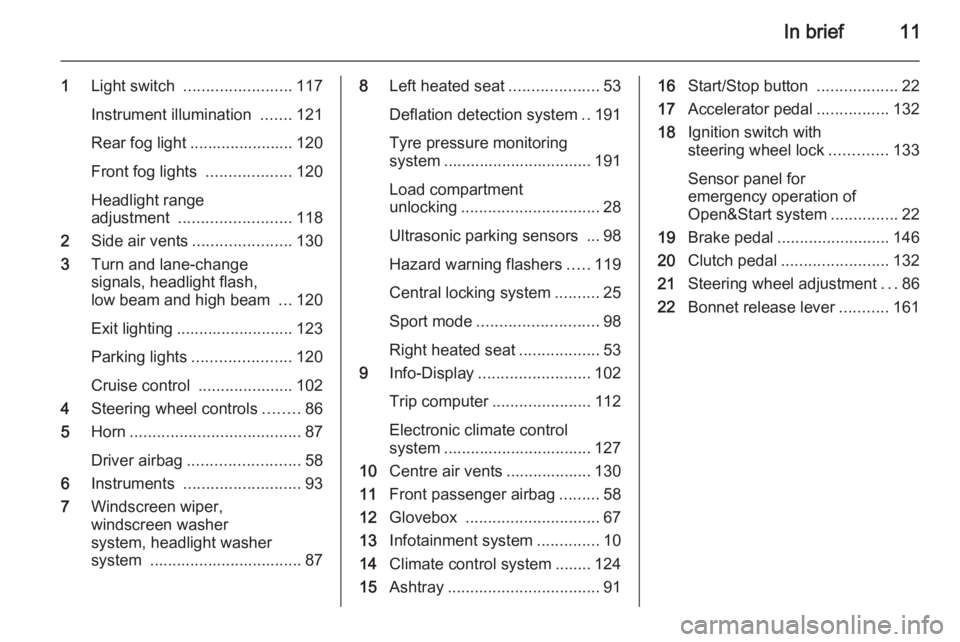
In brief11
1Light switch ........................ 117
Instrument illumination .......121
Rear fog light ....................... 120
Front fog lights ...................120
Headlight range
adjustment ......................... 118
2 Side air vents ...................... 130
3 Turn and lane-change
signals, headlight flash,
low beam and high beam ...120
Exit lighting .......................... 123
Parking lights ...................... 120
Cruise control .....................102
4 Steering wheel controls ........86
5 Horn ...................................... 87
Driver airbag ......................... 58
6 Instruments .......................... 93
7 Windscreen wiper,
windscreen washer
system, headlight washer
system .................................. 878 Left heated seat ....................53
Deflation detection system ..191
Tyre pressure monitoring
system ................................. 191
Load compartment
unlocking ............................... 28
Ultrasonic parking sensors ... 98
Hazard warning flashers .....119
Central locking system ..........25
Sport mode ........................... 98
Right heated seat ..................53
9 Info-Display ......................... 102
Trip computer ...................... 112
Electronic climate control
system ................................. 127
10 Centre air vents ................... 130
11 Front passenger airbag .........58
12 Glovebox .............................. 67
13 Infotainment system ..............10
14 Climate control system ........ 124
15 Ashtray .................................. 9116Start/Stop button ..................22
17 Accelerator pedal ................132
18 Ignition switch with
steering wheel lock .............133
Sensor panel for
emergency operation of
Open&Start system ...............22
19 Brake pedal ......................... 146
20 Clutch pedal ........................ 132
21 Steering wheel adjustment ...86
22 Bonnet release lever ...........161
Page 20 of 245
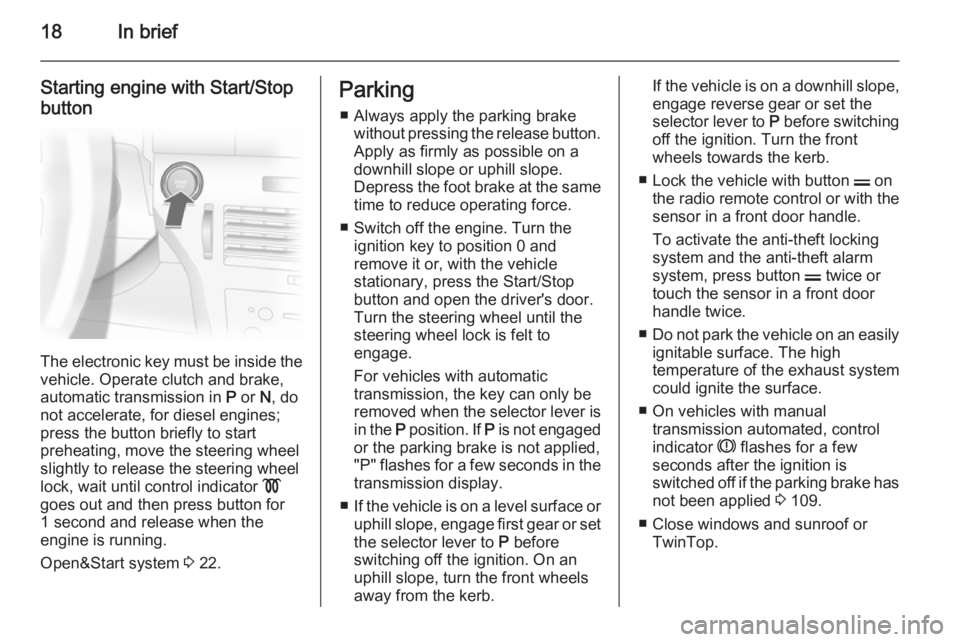
18In brief
Starting engine with Start/Stop
button
The electronic key must be inside the
vehicle. Operate clutch and brake,
automatic transmission in P or N, do
not accelerate, for diesel engines;
press the button briefly to start
preheating, move the steering wheel
slightly to release the steering wheel
lock, wait until control indicator !
goes out and then press button for
1 second and release when the
engine is running.
Open&Start system 3 22.
Parking
■ Always apply the parking brake without pressing the release button.
Apply as firmly as possible on a
downhill slope or uphill slope.
Depress the foot brake at the same time to reduce operating force.
■ Switch off the engine. Turn the ignition key to position 0 and
remove it or, with the vehicle
stationary, press the Start/Stop
button and open the driver's door.
Turn the steering wheel until the
steering wheel lock is felt to
engage.
For vehicles with automatic
transmission, the key can only be
removed when the selector lever is
in the P position. If P is not engaged
or the parking brake is not applied,
"P" flashes for a few seconds in the transmission display.
■ If the vehicle is on a level surface or
uphill slope, engage first gear or set
the selector lever to P before
switching off the ignition. On an
uphill slope, turn the front wheels
away from the kerb.If the vehicle is on a downhill slope, engage reverse gear or set theselector lever to P before switching
off the ignition. Turn the front
wheels towards the kerb.
■ Lock the vehicle with button p on
the radio remote control or with the sensor in a front door handle.
To activate the anti-theft locking
system and the anti-theft alarm
system, press button p twice or
touch the sensor in a front door
handle twice.
■ Do not park the vehicle on an easily
ignitable surface. The high
temperature of the exhaust system
could ignite the surface.
■ On vehicles with manual transmission automated, control
indicator R flashes for a few
seconds after the ignition is
switched off if the parking brake has
not been applied 3 109.
■ Close windows and sunroof or TwinTop.
Page 86 of 245
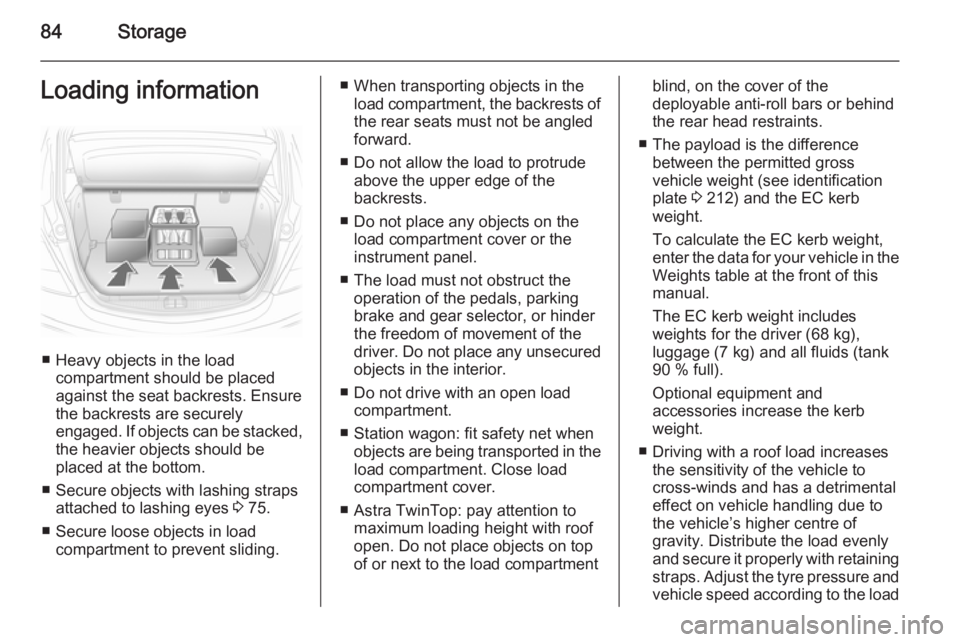
84StorageLoading information
■ Heavy objects in the loadcompartment should be placedagainst the seat backrests. Ensure
the backrests are securely
engaged. If objects can be stacked, the heavier objects should be
placed at the bottom.
■ Secure objects with lashing straps attached to lashing eyes 3 75.
■ Secure loose objects in load compartment to prevent sliding.
■ When transporting objects in theload compartment, the backrests of
the rear seats must not be angled
forward.
■ Do not allow the load to protrude above the upper edge of the
backrests.
■ Do not place any objects on the load compartment cover or theinstrument panel.
■ The load must not obstruct the operation of the pedals, parking
brake and gear selector, or hinder
the freedom of movement of the
driver. Do not place any unsecured objects in the interior.
■ Do not drive with an open load compartment.
■ Station wagon: fit safety net when objects are being transported in theload compartment. Close load
compartment cover.
■ Astra TwinTop: pay attention to maximum loading height with roof
open. Do not place objects on top
of or next to the load compartmentblind, on the cover of the
deployable anti-roll bars or behind
the rear head restraints.
■ The payload is the difference between the permitted gross
vehicle weight (see identification
plate 3 212) and the EC kerb
weight.
To calculate the EC kerb weight,
enter the data for your vehicle in the
Weights table at the front of this
manual.
The EC kerb weight includes
weights for the driver (68 kg),
luggage (7 kg) and all fluids (tank
90 % full).
Optional equipment and
accessories increase the kerb
weight.
■ Driving with a roof load increases the sensitivity of the vehicle to
cross-winds and has a detrimental
effect on vehicle handling due to
the vehicle’s higher centre of
gravity. Distribute the load evenly
and secure it properly with retaining
straps. Adjust the tyre pressure and vehicle speed according to the load
Page 100 of 245
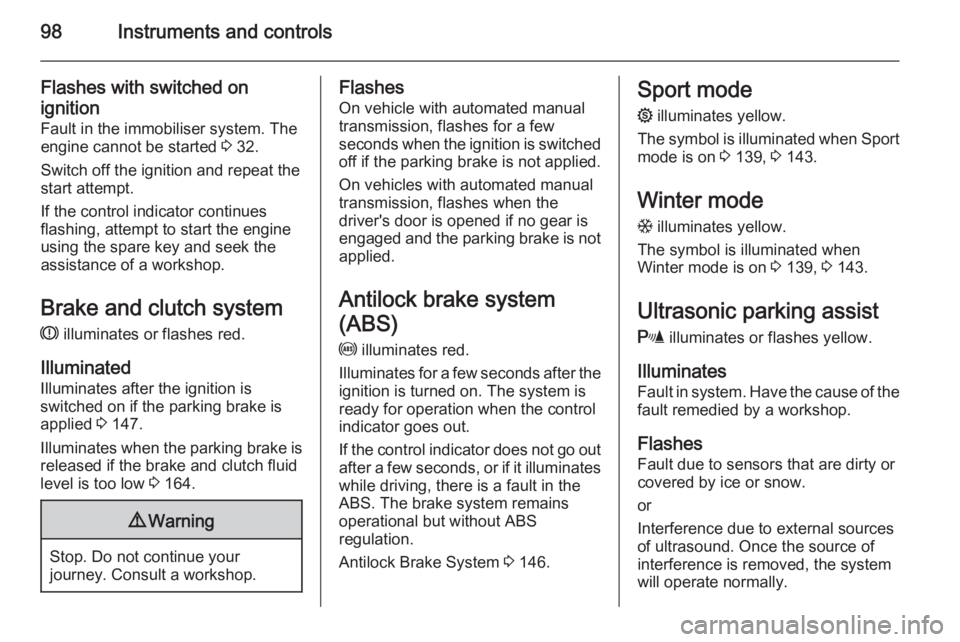
98Instruments and controls
Flashes with switched on
ignition
Fault in the immobiliser system. The
engine cannot be started 3 32.
Switch off the ignition and repeat the
start attempt.
If the control indicator continues
flashing, attempt to start the engine
using the spare key and seek the
assistance of a workshop.
Brake and clutch system R illuminates or flashes red.
Illuminated
Illuminates after the ignition is
switched on if the parking brake is
applied 3 147.
Illuminates when the parking brake is
released if the brake and clutch fluid
level is too low 3 164.9 Warning
Stop. Do not continue your
journey. Consult a workshop.
Flashes
On vehicle with automated manual
transmission, flashes for a few
seconds when the ignition is switched
off if the parking brake is not applied.
On vehicles with automated manual
transmission, flashes when the
driver's door is opened if no gear is
engaged and the parking brake is not
applied.
Antilock brake system
(ABS) u illuminates red.
Illuminates for a few seconds after the ignition is turned on. The system is
ready for operation when the control indicator goes out.
If the control indicator does not go out after a few seconds, or if it illuminates
while driving, there is a fault in the
ABS. The brake system remains
operational but without ABS
regulation.
Antilock Brake System 3 146.Sport mode
1 illuminates yellow.
The symbol is illuminated when Sport
mode is on 3 139, 3 143.
Winter mode
T illuminates yellow.
The symbol is illuminated when
Winter mode is on 3 139, 3 143.
Ultrasonic parking assist
r illuminates or flashes yellow.
Illuminates
Fault in system. Have the cause of the fault remedied by a workshop.
Flashes Fault due to sensors that are dirty or
covered by ice or snow.
or
Interference due to external sources of ultrasound. Once the source of
interference is removed, the system
will operate normally.
Page 101 of 245
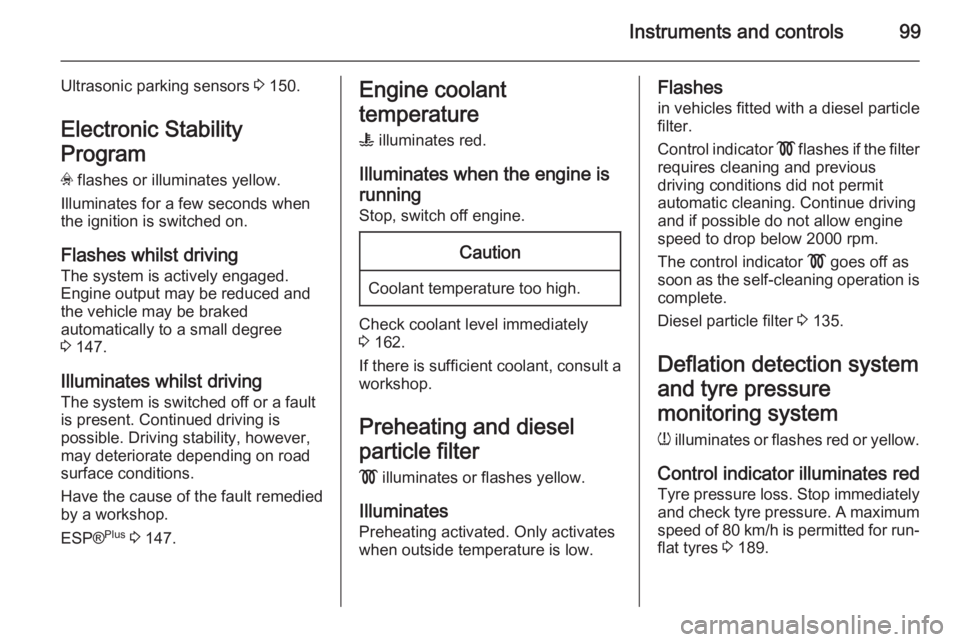
Instruments and controls99
Ultrasonic parking sensors 3 150.
Electronic Stability
Program
v flashes or illuminates yellow.
Illuminates for a few seconds when
the ignition is switched on.
Flashes whilst driving
The system is actively engaged.
Engine output may be reduced and
the vehicle may be braked
automatically to a small degree
3 147.
Illuminates whilst driving The system is switched off or a fault
is present. Continued driving is
possible. Driving stability, however,
may deteriorate depending on road
surface conditions.
Have the cause of the fault remedied
by a workshop.
ESP® Plus
3 147.Engine coolant
temperature
W illuminates red.
Illuminates when the engine is running
Stop, switch off engine.Caution
Coolant temperature too high.
Check coolant level immediately
3 162.
If there is sufficient coolant, consult a workshop.
Preheating and diesel
particle filter
! illuminates or flashes yellow.
Illuminates
Preheating activated. Only activates
when outside temperature is low.
Flashes
in vehicles fitted with a diesel particle
filter.
Control indicator ! flashes if the filter
requires cleaning and previous
driving conditions did not permit
automatic cleaning. Continue driving
and if possible do not allow engine
speed to drop below 2000 rpm.
The control indicator ! goes off as
soon as the self-cleaning operation is complete.
Diesel particle filter 3 135.
Deflation detection system
and tyre pressure
monitoring system
w illuminates or flashes red or yellow.
Control indicator illuminates red Tyre pressure loss. Stop immediately
and check tyre pressure. A maximum speed of 80 km/h is permitted for run- flat tyres 3 189.
Page 111 of 245
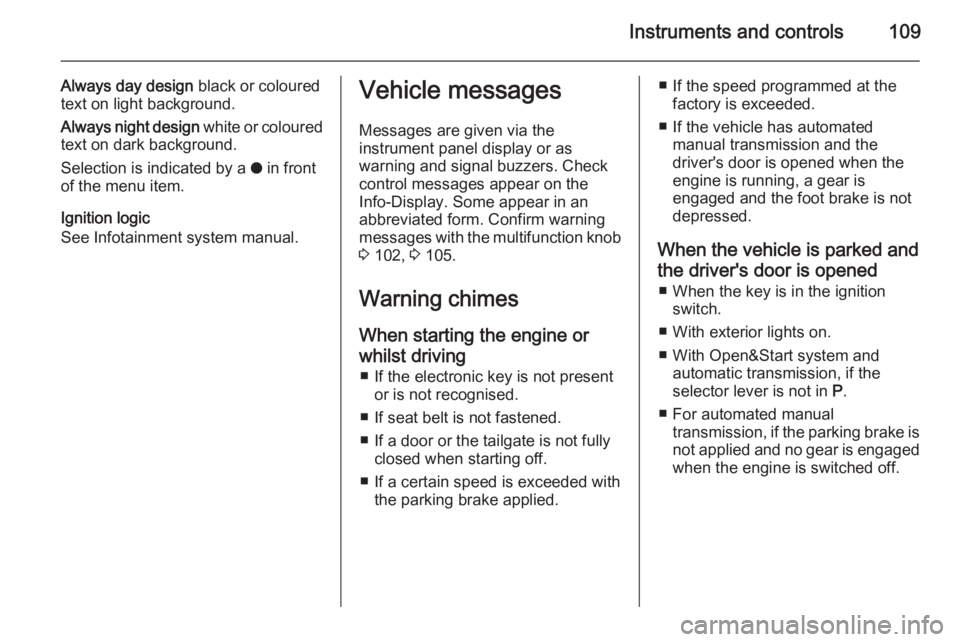
Instruments and controls109
Always day design black or coloured
text on light background.
Always night design white or coloured
text on dark background.
Selection is indicated by a o in front
of the menu item.
Ignition logic
See Infotainment system manual.Vehicle messages
Messages are given via the
instrument panel display or as
warning and signal buzzers. Check
control messages appear on the
Info-Display. Some appear in an
abbreviated form. Confirm warning
messages with the multifunction knob
3 102, 3 105.
Warning chimes
When starting the engine or
whilst driving ■ If the electronic key is not present or is not recognised.
■ If seat belt is not fastened.
■ If a door or the tailgate is not fully closed when starting off.
■ If a certain speed is exceeded with the parking brake applied.■ If the speed programmed at thefactory is exceeded.
■ If the vehicle has automated manual transmission and the
driver's door is opened when the
engine is running, a gear is
engaged and the foot brake is not
depressed.
When the vehicle is parked and the driver's door is opened ■ When the key is in the ignition switch.
■ With exterior lights on.
■ With Open&Start system and automatic transmission, if the
selector lever is not in P.
■ For automated manual transmission, if the parking brake is
not applied and no gear is engaged when the engine is switched off.
Page 136 of 245
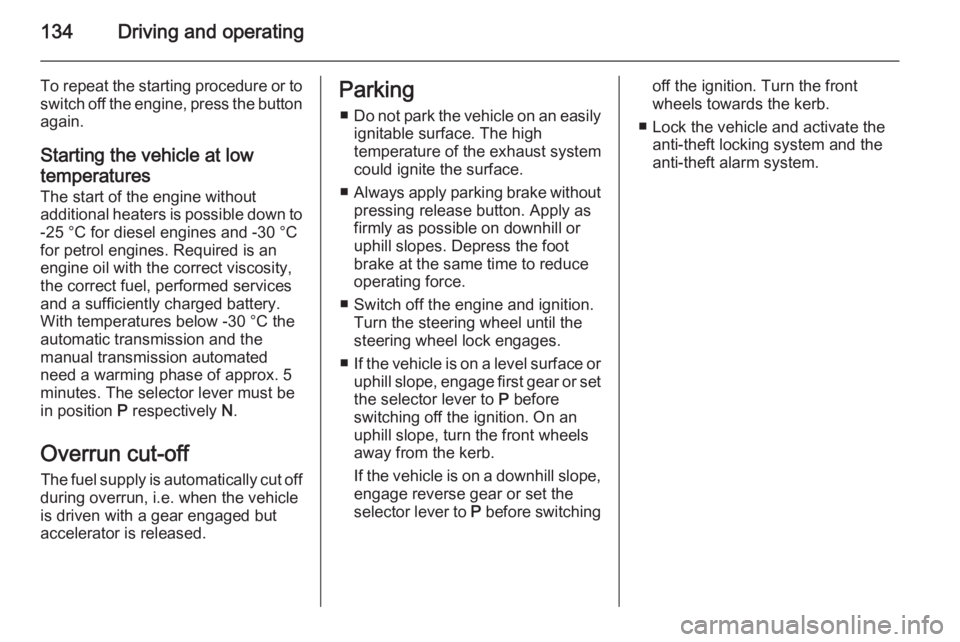
134Driving and operating
To repeat the starting procedure or to
switch off the engine, press the button again.
Starting the vehicle at low
temperatures
The start of the engine without
additional heaters is possible down to -25 °С for diesel engines and -30 °C
for petrol engines. Required is an engine oil with the correct viscosity,
the correct fuel, performed services
and a sufficiently charged battery.
With temperatures below -30 °C the
automatic transmission and the
manual transmission automated
need a warming phase of approx. 5
minutes. The selector lever must be
in position P respectively N.
Overrun cut-off The fuel supply is automatically cut off
during overrun, i.e. when the vehicle
is driven with a gear engaged but
accelerator is released.Parking
■ Do not park the vehicle on an easily
ignitable surface. The high
temperature of the exhaust system
could ignite the surface.
■ Always apply parking brake without
pressing release button. Apply as
firmly as possible on downhill or
uphill slopes. Depress the foot
brake at the same time to reduce
operating force.
■ Switch off the engine and ignition. Turn the steering wheel until the
steering wheel lock engages.
■ If the vehicle is on a level surface or
uphill slope, engage first gear or set
the selector lever to P before
switching off the ignition. On an uphill slope, turn the front wheels
away from the kerb.
If the vehicle is on a downhill slope, engage reverse gear or set the
selector lever to P before switchingoff the ignition. Turn the front
wheels towards the kerb.
■ Lock the vehicle and activate the anti-theft locking system and the
anti-theft alarm system.
Page 139 of 245
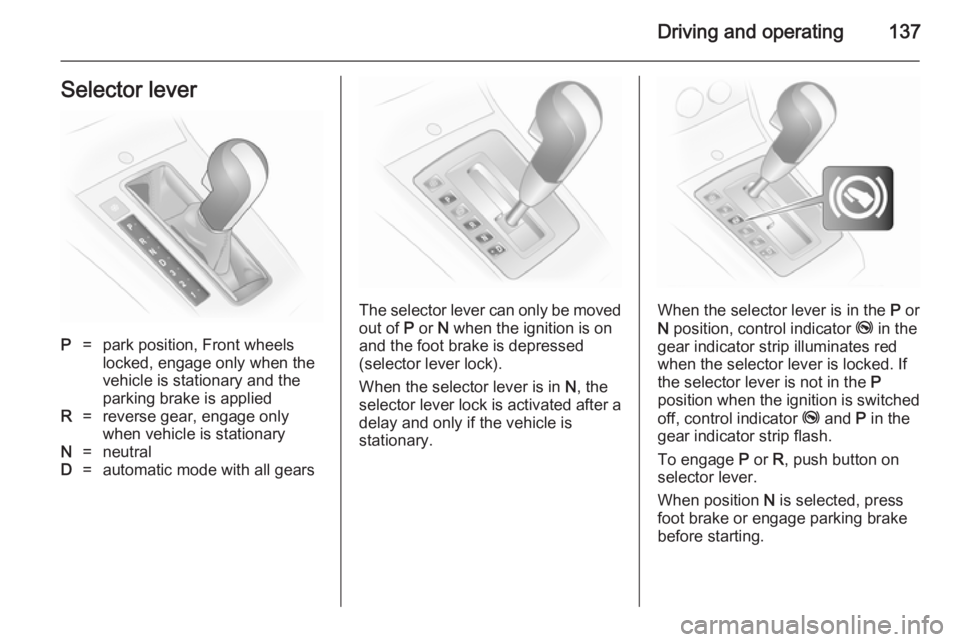
Driving and operating137Selector leverP=park position, Front wheels
locked, engage only when the
vehicle is stationary and the
parking brake is appliedR=reverse gear, engage only
when vehicle is stationaryN=neutralD=automatic mode with all gears
The selector lever can only be moved out of P or N when the ignition is on
and the foot brake is depressed
(selector lever lock).
When the selector lever is in N, the
selector lever lock is activated after a
delay and only if the vehicle is
stationary.When the selector lever is in the P or
N position, control indicator j in the
gear indicator strip illuminates red
when the selector lever is locked. If
the selector lever is not in the P
position when the ignition is switched
off, control indicator j and P in the
gear indicator strip flash.
To engage P or R, push button on
selector lever.
When position N is selected, press
foot brake or engage parking brake
before starting.
Page 140 of 245
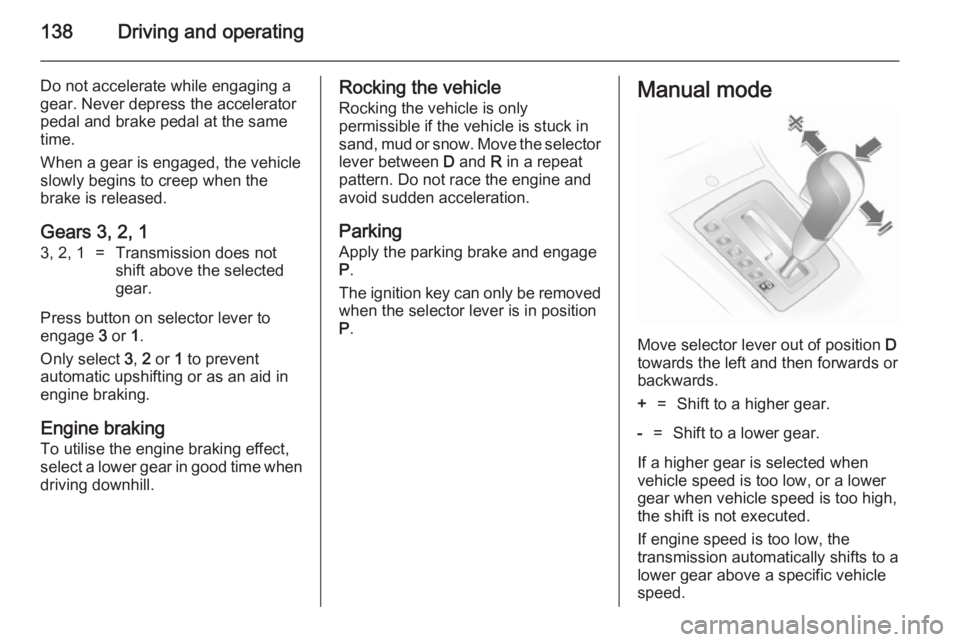
138Driving and operating
Do not accelerate while engaging a
gear. Never depress the accelerator
pedal and brake pedal at the same
time.
When a gear is engaged, the vehicle
slowly begins to creep when the
brake is released.
Gears 3, 2, 13, 2, 1=Transmission does not
shift above the selected
gear.
Press button on selector lever to
engage 3 or 1.
Only select 3, 2 or 1 to prevent
automatic upshifting or as an aid in
engine braking.
Engine braking
To utilise the engine braking effect,
select a lower gear in good time when
driving downhill.
Rocking the vehicle
Rocking the vehicle is only
permissible if the vehicle is stuck in
sand, mud or snow. Move the selector
lever between D and R in a repeat
pattern. Do not race the engine and
avoid sudden acceleration.
Parking
Apply the parking brake and engage P .
The ignition key can only be removed
when the selector lever is in position
P .Manual mode
Move selector lever out of position D
towards the left and then forwards or backwards.
+=Shift to a higher gear.-=Shift to a lower gear.
If a higher gear is selected when
vehicle speed is too low, or a lower
gear when vehicle speed is too high,
the shift is not executed.
If engine speed is too low, the
transmission automatically shifts to a
lower gear above a specific vehicle
speed.
Page 142 of 245

140Driving and operating
Kickdown
If the accelerator pedal is pressed
past the pressure point, the
transmission shifts to a lower gear depending on engine speed.
Fault
In the event of a fault, A illuminates.
The transmission no longer shifts
automatically. Continued travel is
possible with manual shifting.
Have the cause of the fault remedied
by a workshop.
Version without manual mode
2nd gear is not available. Manual
shifting:1=1st gear2=3rd gear3, D=4th gear
Version with manual mode
Only the highest gear is available.
Depending on the fault, 2nd gear may also be available in manual mode.
Interruption of power
supply
In the event of an interruption of
power supply, the selector lever
cannot be moved out of the P or N
position.
If the battery is discharged, start the
vehicle using jump leads 3 200.
If the battery is not the cause of the
fault, release selector lever:
1. Apply parking brake.2. Release selector lever trim from centre console at rear, fold
upwards and rotate to the left.